The Difference Between Bees and Wasps
As the weather begins to warm up and we leave our windows and doors open and spend more time outdoors, you will no doubt be pestered by flying insects including bees and wasps, amongst others.
Whilst you may be tempted to kill a pesky wasp as it buzzes around you, you may not be as keen to kill a bee. But can you tell the difference? And what exactly are the differences between wasps and bees?
Bees and wasps both belong to the Hymenoptera order, which means membraneous wings, and includes honeybees, bumblebees, solitary bees, hornets, wasps, sawflies and ants.
Wasps differ to bees in several ways. For example they do not use nectar to make honey in the same way as bees do. They are not active throughout the entire year like bees, and although wasps will swarm feed, they do not swarm in the same fashion as honeybees.
What’s the buzz?
Wasps and honeybees are often mistaken for one another as visually they appear similar in body shape and colouring, and both insects are capable of giving painful stings! Bumblebees are completely different with their rounder, fatter looking body and furry appearance.
Honeybees will remain active all year round and store food (honey) in the nest or hive. Their colonies are extremely well organised and they don’t hibernate, during the winter months they simply cluster together to create heat taking turns to move from the warm inside of the cluster to the colder outside. A typical colony can have a population of anywhere between 30,000 to 50,000 bees! Managed honeybees will often be fed supplementary food during the winter by their beekeepers.
Bumblebees are only active during the late spring and summer months and the queen bumblebee is generally the only one of her species to survive the winter by hibernating. She will build a nest with moss and/or leaves during the spring, and then incubate her larvae inside wax cells that she’s constructed within the nest. As the larvae hatch and fly, the queen will remain in the hive producing young. A typical bumblebee colony is much smaller than the honeybee – usually somewhere between 50 to 100 bees.
Similar to bumblebees, wasps will begin a new season with a single queen that has survived the winter by hibernating. In the spring, the queen emerges from hibernation to find somewhere to start a brand new nest. She will construct her new nest using paper, and it will continue to increase in size throughout the summer. At the end of the season, usually autumn, the nest will produce new queens and males which will leave the nest to mate, the males then die off and the fertilised queens find somewhere to hibernate through the winter. The average wasp colony usually has a population of around 2,000.
A prickly subject
Honeybees can attack when provoked but it is only the female worker bees that will sting as they have a sharp, barbed stinger that pierces the skin to inject venom called apitoxin. Because of the barbs, the stinger is left in its victim and the bee will die soon afterwards. The queen bee also has a stinger, albeit a smooth one, but she doesn’t usually leave the nest so is unlikely to use it. The male drone bees are not equipped with a stinger so cannot sting. A honeybee will only sting if it feels threatened or if it’s protecting its colony.
Bumblebees are not as defensive as honeybees so are less likely to sting, however they will attack if provoked. Typically, an attack will happen near their hive and pollen store, which they’ll defend. Unlike the honeybee, a bumblebee doesn’t leave behind a venom sac when it stings, which may be why some say a bumblebee sting isn’t as painful as that from a honeybee or a wasp. However, a bumblebee stinger is smooth (no barbs) so remains attached to the bee to be used multiple times! The male drone bees don’t sting, it is only the queen and the female workers who have a stinger.
Wasps are carnivores and so are naturally more aggressive predators. They can sting when provoked and their stinger has smaller barbs so doesn’t get left behind, meaning it can sting more than once. It’s also worth bearing in mind that the venom in wasps contains a pheromone that causes other wasps in the vicinity to become more aggressive. Normally a wasp will leave you alone if you don’t threaten it, so try to avoid flapping hands or swatting it, which will make it feel threatened and provoke it. Wasps tend to be more of a nuisance towards the end of the summer when they’ve finished raising their young and are free to feast on whatever they choose. At this time of year the hierarchy in the colony is also breaking down and the wasps are disoriented and often homeless. This is why they become an annoyance to humans as they buzz around our rubbish bins containing rotting food, or picnic tables topped with sugary food and drink and fruit.
In most cases a bee or wasp sting causes no long term harm and should wear off within 24 hours. However, for a small minority of people the venom in their sting causes anaphylactic shock which can be life threatening.
The same difference?
Bumblebees are easy to spot, with their rotund, hairy bodies. But at first glance it may be difficult to tell the difference between a honeybee and a wasp, and these two insects are often confused for one another, so below is a basic guide to help differentiate between these two insects.
| Honeybee | Wasp | |
| Size | Approximately 15mm. | Approximately 10-15mm, the Queen can be 20mm. |
| Colour | Entirely black or black or brown with orange or yellow stripes. | Black with bright yellow stripes. |
| Skin | Hairy or furry. | Smooth and shiny. |
| Shape | Stout. | Stout often with a narrow waist. |
| Flying | Legs hang whilst flying often carrying pollen. | Legs tucked up when flying. |
| Sting | Stings just once then dies. | Stings multiple times. |
| Behaviour | Not aggressive, unless defending nest. | Very aggressive, especially when provoked. |
| Food | Pollinator - collects pollen and nectar from flowers. | Predator - sweet food and drinks, decaying fruit and meat. |
| Nest | Large honeycomb nests in sheltered location. | Papery nest usually in an sheltered area. |
Busy bees
There are around 250 species of bee in the UK; 24 species of bumblebee (25 if you count the reintroduced short-haired bumblebee); around 225 species of solitary bee; and just a single honeybee species. Bumblebees look quite different from honeybees and solitary bees.
In the UK about 70 crops are dependent on, or benefit from, bees. In addition, bees pollinate the flowers of many plants which become part of the feed for farm animals. This is why the economic value of honeybees and bumblebees as pollinators of commercially grown insect pollinated crops in the UK has been estimated at over £200 million per year.
Sadly, bees are in danger of disappearing from our environment. Solitary bee and bumblebee natural habitats are at risk from farming practices and are declining at a rate which gives them little chance for re-establishment. The honeybee is at risk from a decline in pollen-rich plants, chemicals and fertilisers, and an increase in the prevalence of Varroa Destructor mite within beehives, and although treatment and care provided by beekeepers is keeping colonies alive, unfortunately most wild honeybee colonies have died out as a result of this disease.
For the European honeybee a hollow tree provides the ideal habitat. A dry, dark, cavity with a wooden roof which the bees can fix their combs to, protected from rain and wind and with some insulation (although honey bees have such a good air conditioning system that this need only be minimal). A small entrance helps the bees guard against wasps and alien honeybees that might want to steal their honey. Many honeybees are kept by a beekeeper who provides an artificial habitat in which he tries to meet these criteria. However, he also imposes restrictions, which help him to look after the bees and take some honey without harming the bees.
Bumblebee nests are located in much smaller cavities because the colony is smaller and so they need more insulation, and the queen bee has to start alone in cold weather without workers to help maintain the temperature. Queen bumblebees look for places that already have bedding material, such as old mouse nests, in the ground or under sheds or in compost heaps made of fibrous plant material. They will even use old bird nesting boxes sometimes.
Waspish behaviour
It’s a common misconception that wasps serve no purpose and are simply annoying and aggressive insects that were put on earth to irritate humans during the summer months. However, this is not the case. In the early summer wasps, like bees, are important pollinators - they love to drink sweet nectar and as they visit flowers they transfer pollen. As predators, they also control the numbers of pests such as greenfly.
So wasps definitely do serve a useful purpose and despite being a problem at certain times of the year and irritating to humans, they are a beneficial insect and have their role to play.
Wasps are predatory insects and spend a lot of their time hunting and catching smaller insects to feed to their larvae. The prey is killed by the adult wasp and chewed into small food parcels to be taken back to the nest. This is then fed to the larvae which turn the exoskeletons of the prey into a sugary solution which they feed back to the adult wasps.
Wasps are most active in the warm summer months and in the UK, it’s the common wasp and European (or German) wasp that cause the most annoyance and painful stings.
Some wasps will build their nests in the eaves of a house, in a garden shed, inside an air brick or even in the ground, whilst others will build their nests in bushes, trees, hedgerows and even underground. Wasps tend to build their nests where they’ll be undisturbed and protected from the elements. The nest itself is constructed using chewed wood and saliva to make a papier-mâché material and the result is a strong, lightweight and surprisingly waterproof dwelling.
Pretty as a picture
| Bumblebee | Honeybee | European wasp |
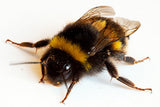 |
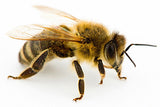 |
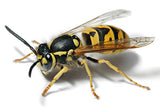 |
Home from home
| Bumblebee nest | Honeybee nest | Wasp nest |
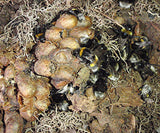 |
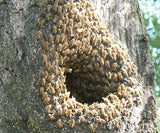 |
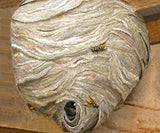 |
References
Hopefully this has helped you tell the differences between honeybees, bumblebees and wasps. The internet has, once again, proved an invaluable resource and there are many websites that you can visit which will provide you with more in-depth information.
This guide has only discussed two types of bee, but there are many more buzzing around the UK. You can check various types of bees in the UK at Bee Life https://www.beelife.org/
Below are some links to sites that I’ve used to help produce this guide:
Bumblebees
https://bumblebeeconservation.org/
http://www.bumblebee.org/
https://en.wikipedia.org/wiki/Bumblebee
http://www.nhm.ac.uk/research-curation/research/projects/bombus/bumblebeeid.html
Honeybees
http://www.bbka.org.uk/
https://en.wikipedia.org/wiki/Honey_bee
http://www.friendsofthehoneybee.com/
Wasps
https://animalcorner.co.uk/animals/wasps/
https://en.wikipedia.org/wiki/Wasp
http://www.bpca.org.uk/pages/?page_id=226








